Cardinalidae
| Cardinalids | |
|---|---|

| |
| Male breeding dickcissel (Spiza americana). | |

| |
| Male northern cardinal (Cardinalis cardinalis). | |
| Scientific classification | |
| Domain: | Eukaryota |
| Kingdom: | Animalia |
| Phylum: | Chordata |
| Class: | Aves |
| Order: | Passeriformes |
| Superfamily: | Emberizoidea |
| Family: | Cardinalidae Ridgway, 1901 |
| Type species | |
| Loxia cardinalis | |
| Genera | |
|
Habia | |
Cardinalidae (sometimes referred to as the "cardinal-grosbeaks" or simply the "cardinals") is a family of New World-endemic passerine birds that consists of cardinals, grosbeaks, and buntings. It also includes several other genera such as the tanager-like Piranga and the warbler-like Granatellus. Membership of this family is not easily defined by a single or even a set of physical characteristics, but instead by molecular work. Among songbirds, they range from average-sized to relatively large, and have stout features, some species with large, heavy bills.
Members of this group are beloved for their brilliant red, yellow, or blue plumages seen in many of the breeding males in this family. Most species are monogamous breeders that nest in
In terms of conservation, most members of this family are considered
Field characteristics
The grosbeaks, seedeaters, and cardinals have large bills, while Granatellus and buntings have small bills. The cardinalid tanagers have stout, near pointed bills, with some species of Piranga having serrations along the edge of their upper bills.[1] This bill shape is not always an indicator of relationships, as the various species of blue cardinalid species, like the blue grosbeak and Cyanoloxia grosbeaks are related to the buntings. Similarly, the cardinalid tanagers are closer to the cardinals and masked grosbeaks (see more in the systematics section). The head is medium to large in size, with a medium neck length. The body of cardinalids ranges from small to medium with lengths of 4.5 to 11 in (11 to 28 cm). Legs are also short to medium in length. The wings are medium and pointed. Cardinalids have nine visible primary feathers with the tenth primary feather being short in comparison.[2][3][4]
The plumages in cardinalids are sexually dichromatic as many males of various species display bright reds, oranges, blues or blacks. In most temperate species, males will undergo molting between seasons, so that non-breeding males will somewhat resemble the females of their species. These species, such as the indigo bunting, will exhibit a complex molt cycle going through four different stages of plumage coverage within their first year of life. From spring to summer, birds start with juvenile plumage to supplemental plumage, then changing to a first basic (nonbreeding) plumage from fall to winter, and finally reaching the first alternate (breeding) plumage. Adults will typically have the basic two molt cycle changing to basic or partial in the late summer or fall, and then back to alternate again in the spring. Males of tropical species will have the same coloration year-round. Females of all species are either drabber in coloration by comparison, often having a lighter coloration of the males. The molting pattern in most cardinalids exhibits delayed plumage maturation, causing the first-year male birds to often be in non-breeding plumage or at an intermediate stage.[2] The molting pattern in cardinalids is divided into two types. A preformative molt is a partial molt where only the body feathers get replaced, but not the wing and tail feathers, which is seen in a lot of temperate and neotropical species. The second type is an eccentric preformative molt when only the outer primary and inner secondaries are replaced. This molt is seen in some species of Cyanoloxia and Passerina.[5][6]
Systematics
Traditionally, members of this group were classified as a tribe of the
The cardinalids are part of a larger grouping of American endemic songbirds, Emberizoidea, which also includes the aforementioned thraupids and parulids, as well as icterids (New World blackbirds), passerellids (New World sparrows), and several families that contain one or a couple of genera. Several studies have placed cardinalids as either the sister group to Thraupidae,[9] Mitrospingidae (a small family whose genera were formerly classified as thraupids),[11] or the sister to a clade containing thraupids and mitrospingids.[10] At least one study suggested that cardinalids could treated as a subfamily of Thraupidae.[12]
Phylogeny
Phylogeny of the cardinalid genera after Klicka et al. (2007).[8]
| Cardinalidae |
| |||||||||||||||||||||||||||||||||||||||||||||||||||||||||||||||||||||||||||||||||
Species list
These 53 species and 14 genera are recognized by the IOC as of January 2023:[13]
| Image | Genus | Living species |
|---|---|---|
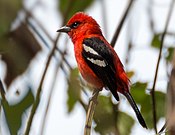 |
Piranga Vieillot, 1808 |
|
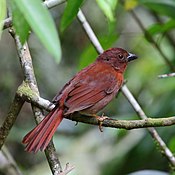 |
Habia Blyth, 1840 |
|
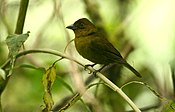 |
Chlorothraupis Salvin & Godman, 1883 |
|
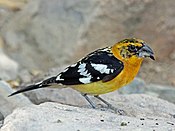 |
Pheucticus L. Reichenbach, 1850 |
|
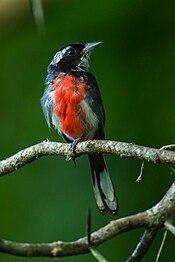 |
Granatellus Bonaparte, 1850 |
|
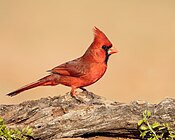 |
Cardinalis Bonaparte, 1838 |
|
 |
Caryothraustes L. Reichenbach, 1850 |
|
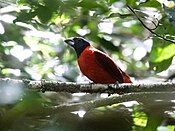 |
Periporphyrus L. Reichenbach, 1850 |
|
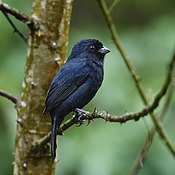 |
Amaurospiza Cabanis, 1861 |
|
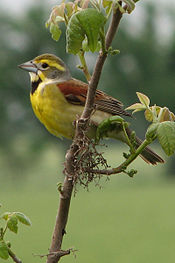 |
Spiza Bonaparte, 1824 |
|
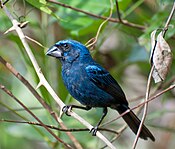 |
Cyanoloxia Bonaparte, 1850 |
|
 |
Cyanocompsa Cabanas, 1861 |
|
 |
Passerina Vieillot, 1816 North American buntings |
|
Natural history
Habitat, distribution and migration
The cardinalids can be found from
Feeding ecology
Cardinals, the dickcissel, seedeaters, buntings, and grosbeaks have the thicker, seed-crushing bills that enabled them to feed heavily on fruits and seeds outside of the breeding season (especially in the winter for northern species like the aforementioned dickcissel and northern cardinal). Once their breeding season begins, members of this group will supplement themselves with invertebrate prey, vital when raising their young and refueling their energetic costs of reproduction and other daily activities. The genera Chlorothraupis, Habia, Piranga, and Granatellus have slightly longer and less deep bills, which their diet mostly consists of insects, fruit, nectar and sap, less so on seeds.[4] Cardinalids typically forage alone low level or on the ground, though some like Piranga and grosbeaks will forage high in the tree canopy. Many will come to birdfeeders especially during the winter.[2]
Breeding and reproduction

Nearly all cardinalids are
Conservation

As of 2021, the IUCN Red List has nearly 82 percent of cardinalids to be
Despite the vast majority of species being classified as least concern, there has been a growing concern in how the ongoing climate crisis will affect the distribution and migration of many species across the globe. One study led by Dr. Brooke L. Bateman published in July 2020 focused on the risk North American birds will face from climate change and the measures needed to protect them. The first study assessed 604 species from the United States found that if the planet warmed by 3.0 degrees Celsius many species, especially arctic birds, waterbirds, and boreal and western forest birds, will be highly vulnerable to climate change and future conservation efforts will need to be in place.[15] Among the species sampled, the North American species of Piranga and Pheucticus are found to be most climate vulnerable of the cardinalids.[16] These species will either lose some substantial amount of their range or they will migrate up north to escape the sudden change in their habitat.
A possible extinct species is the controversial Townsend's bunting, a supposed enigmatic species related to the dickcissel. The Townsend's bunting is only known from a single type specimen collected from Chester County, Pennsylvania by John Kirk Townsend and described by John James Audubon in 1834. The specimen is housed in the National Museum of Natural History. Genetic work has not been done on this bird, but observation of the plumage has been done. The controversy stems from the uncertainty from authors whether the bird is an extinct species, a rare color-variant of the dickcissel, or a hybrid female dickcissel and male blue grosbeak. If the bird is indeed simply a dickcissel it lacks any of the known field characteristics seen in the species in all life stages and sexes.[17]
References
- ^ ISBN 1400043867.
- ^ ISBN 1400043867.
- ^ ISBN 978-0358164074.
- ^ S2CID 216193779. Retrieved 7 January 2022.
- S2CID 228930759.
- ^ .
- JSTOR 4160878.
- ^ PMID 17920298.
- ^ S2CID 53058340.
- ^ PMID 30936315.
- PMID 23229025.
- PMID 25837731.
- Rasmussen, Pamela, eds. (January 2023). "Cardinals, grosbeaks and (tanager) allies". IOC World Bird List Version 13.1. International Ornithologists' Union. Retrieved 25 February 2023.
- ^ ISBN 9781426204036.
- S2CID 225453243.
- ^ Waters, H. (10 October 2019). "The Future for Birds". Audubon. Retrieved 7 January 2022.
- ISBN 9781472937469.
External links
- Cardinalidae videos, photos and sounds on the Internet Bird Collection
- Cardinalidae sounds on xeno-canto.org
- Northern cardinal (bird information) on petinfospot.com
- Northern cardinal, including sound and video clips, on Cornell Lab of Ornithology


